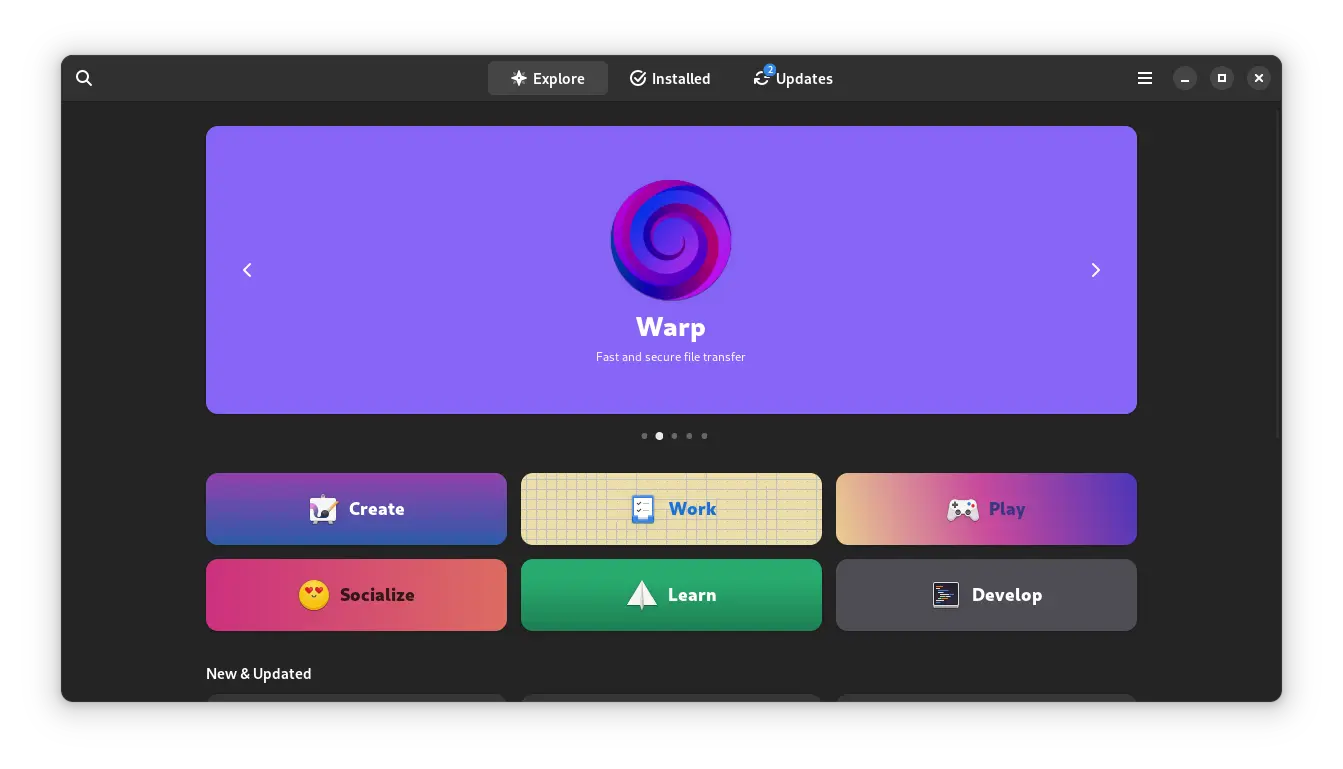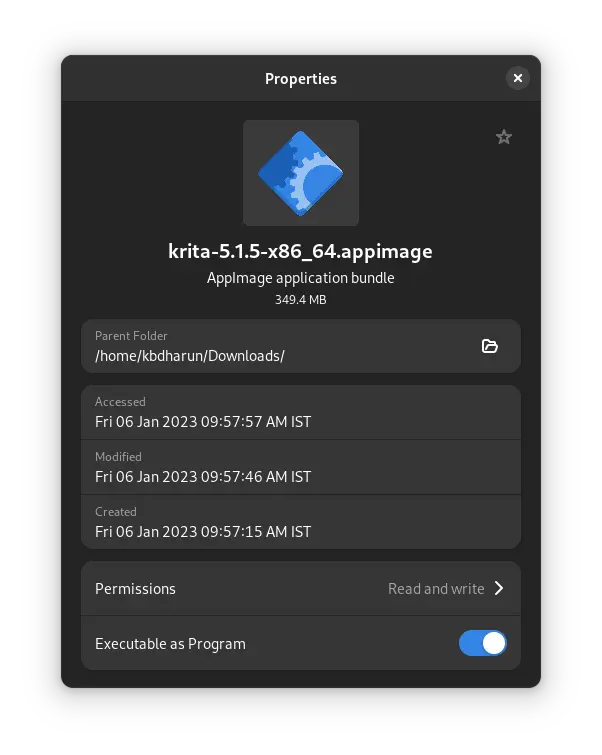Note: This guide is for Kinetic (22.10). For newer versions of Vanilla OS, refer to https://docs.vanillaos.org/collections/handbook for the latest documentation.
Introduction
Vanilla OS allows installing packages and software from various sources. This guide will discuss them in detail.
Vanilla OS comes with the option to enable Flatpak and AppImage in the initial setup. It also allows the installation of native packages using the apx package manager.
Terminologies
-
Flatpak:- Flatpak is a popular packaging format allowing the installation of Desktop applications in a sandboxed environment isolated from the system with shared libraries between them. Flatpak provides developers with a unified way to distribute apps for most GNU/Linux distributions. Flatpak supports adding various remote repositories, the most popular repository being Flathub.
-
Flathub:- Flathub is the largest repository of Flatpak applications spanning various categories.
-
AppImage:- AppImage is a format for distributing portable software or executables on Linux without needing superuser permissions to install the application.
-
GNOME Software:- GNOME Software allows you to find, install and remove new applications and system extensions. It showcases screenshots, metadata and user reviews of various applications. In Vanilla OS, it supports installing Flatpaks and Vanilla OS (Apx) meta packages. GNOME Software is the Linux equivalent of the Microsoft Store, Play Store and App Store.
-
Package Manager:- A package manager or package-management system is a utility with a collection of software tools that automates installing, upgrading, configuring, and removing applications or packages.
apxis the package manager which comes with Vanilla OS. It is the equivalent command for Winget on Windows. -
APX:-
apxis the default package manager in Vanilla OS. It allows installing applications from multiple sources in managed containers. -
APT:-
aptis an Advanced Package Tool which allows installing and managing software on Debian and Debian-based systems like Ubuntu. -
DNF:-
dnf(Dandified YUM) is the successor to YUM. It is a powerful package manager for installing and managing applications on rpm-based distributions. -
AUR:-
aur(Arch User Repository) is the largest community-maintained repository with thousands of native packages for Arch Linux and its derivatives. -
APK:-
apk(Alpine Linux package keeper) is a package manager which allows installing and managing applications on Alpine Linux. -
ZYPPER:-
zypperis a package manager on openSUSE for installing, updating and removing packages, and also for managing repositories. -
XBPS:-
xbps(X Binary Package System) is a fast package manager on Void Linux that has been designed and implemented from scratch for efficiently managing your packages. -
NIX:-
nixis a powerful package manager for Linux and other Unix systems that makes package management reliable and reproducible. -
DEB:-
deb(Debian Packages) is a file format for installing and managing applications on Debian-based systems. It’s an equivalent file extension to.exein Windows and.rpmin GNU/Linux. -
RPM:-
rpm(Red Hat package manager) is a file format for installing and managing applications on RHEL-based systems. It’s an equivalent file extension to.exein Windows and.debin GNU/Linux.
Managing Applications through GNOME Software
Installing Applications
Flatpaks can be installed with ease using GNOME Software. It is the recommended method for installing packages.

Searching Applications
You can search for applications in GNOME Software by clicking on the Search icon in the top left corner.
If the application you searched for exists, it will be displayed, and you can proceed with the installation.
If the application you searched for does not exist, you can use an alternative method suggested below in this guide to install it.
Updating Applications
Updates are visible in the Updates panel in GNOME Software. In Vanilla OS, Updates are available for Flatpaks and System Packages in GNOME Software.
Automatic Updates are configured in the Update Preferences tab located in the burger menu in the top right corner.

Removing Applications
You can remove installed Flatpaks from the Installed panel.
(Note: Some native applications installed on the host cannot be removed using this method, but applications installed through the meta plugin can be removed through the panel.)
Manage AppImages
Installing AppImages
You can download AppImages from project pages on GitHub. Another source for AppImages is AppImageHub.
Once downloaded, they won’t have to be installed since they are executable binaries.
Running AppImages
If you have enabled AppImage in the first setup, you can run AppImages graphically by following these steps:-
- Right-click on the file, then click on Properties.

- Enable the Executable as Program option.
You can now run the AppImage by right-clicking it and pressing run or by pressing enter/return key on your keyboard.
Alternatively, you can open AppImages from the terminal with the following commands:-
cd <directory>
chmod +x <file>.appimage
./<file>.appimage
Note:- chmod +x <file>.AppImage makes the file executable.
Managing Flatpaks through CLI
If you enabled Flatpak in the First Setup, you won’t have to do anything. If you have disabled Flatpak in the First Setup, follow the guide here.
Installing Flatpaks
You can install Flatpaks with the following command:-
flatpak install <application-id>
Running Flatpaks
You can run the Flatpaks using the desktop entry (icon) from the Application menu.
You can alternatively run Flatpaks in the terminal with the following command:-
flatpak run <application-id>
Removing Flatpaks
You can remove installed Flatpaks with the following command:-
flatpak uninstall <application-id>
You can remove unused Flatpak dependencies with the following command:-
flatpak uninstall --unused
You can remove leftover data of Flatpaks with the following command (Disclaimer: Proceed with caution, since this removes all application data):-
flatpak uninstall --delete-data <application-id>
Managing Applications through Apx
Apx allows installing applications from various Linux distributions. These applications are tightly integrated with the host and can access the host’s hardware.
In the commands below, <package_manager> will be a placeholder. It can be replaced by the following options:-
aptdnfaurapkzypperxbpsnix
Creating a Container
You can create a container with the following command:-
apx init --<package_manager>
You can also initialize the containers graphically by clicking on the + icon in the Vanilla Control Center. (Vanilla Control Center allows you to enter the apx container graphically.)

After initialization, you can enter the container graphically by clicking on the terminal icon.

Installing Applications with Apx
You can install applications with the following command:-
apx install --<package_manager> <package>
This command will automatically detect the desktop file entry in the package and add it to the Application menu and Vanilla Control Center.
You can install DEB packages with the following command:-
apx install --sideload <path/to/package.deb>
You can install RPM packages with the following command:-
apx install --dnf --sideload <path/to/package.rpm>
If your application’s desktop entry isn’t detected automatically, you can export it manually with the following command:-
apx export --<package_manager> <package>
You can export binaries to run them without the apx run prefix with the following command:-
apx export --<package_manager> --bin <package>
Uninstalling Applications with Apx
You can uninstall applications with the following command:-
apx remove <packages>
This command will automatically detect and remove the desktop file entry.
If your application’s desktop entry is not automatically removed, you can unexport it manually with the following command:-
apx unexport --<package_manager> <package>
You can unexport binaries with the following command:-
apx unexport --<package_manager> --bin <package>